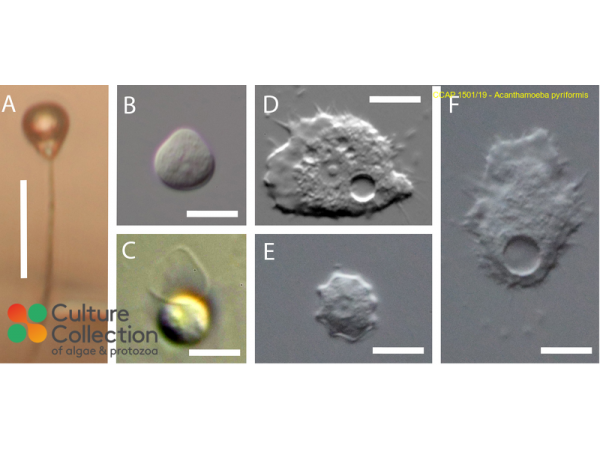References [ 3 ]
Tice AK, Shadwick LL, Fiore-Donno AM, Geisen S, Kang S, Schuler GA, Spiegel FW, Wilkinson KA, Bonkowski M, Dumack K, Lahr DJG, Voelcker E, Clauß S, Zhang J & Brown MW (2016) Expansion of the molecular and morphological diversity of Acanthamoebidae (Centramoebida, Amoebozoa) and identification of a novel life cycle type within the group. Biology Direct 11: 69.
Fuerst, PA (2023) The status of molecular analyses of isolates of Acanthamoeba maintained by international culture collections. Microorganisms 11(2): 295.
Fuerst PA & Booton GC (2020) Species, sequence types and alleles: Dissecting genetic variation in Acanthamoeba Pathogens 9(7): 534.
Sequences [ 1 ]
EMBL/Genbank Links
(Bold text = submission by CCAP staff or collaborators)
Division/Phylum: Amoebozoa Class: Discosea
Note: for strains where we have DNA barcodes we can be reasonably confident of identity, however for those not yet sequenced we rely on morphology
and the original identification, usually made by the depositor. Although CCAP makes every effort to ensure the correct taxonomic identity of strains, we cannot guarantee
that a strain is correctly identified at the species, genus or class levels. On this basis users are responsible for confirming the identity of the strain(s) they receive
from us on arrival before starting experiments.
For strain taxonomy we generally use AlgaeBase for algae and
Adl et al. (2019) for protists.
| Attributes |
| Authority | Spiegel & Shadwick 2016 |
| Isolator | Tice (2015) |
| Collection Site | dead leaf litter from a deciduous forest 8.783 deg N, -82.967 deg E; Costa Rica |
| Notes |
cystformer; neotype specimen; Acanthamoeba pyriformis CR15 Transcriptome: SAMN05763314; image key - A) sporocarp B)spore detached from stalk C) empty spore wall and rounded trophic cell D) trophic cell E) cyst F) trophic cell |
| Axenicity Status |
Bacteria present |
| Area |
North America |
| Country |
Costa Rica |
| Environment |
Soil |
| GMO |
No |
| Group |
Protozoa |
| In Scope of Nagoya Protocol |
No |
| ABS Note |
Collected post Nagoya Protocol from a country with no ABS measures at time of access. No known Nagoya Protocol restrictions for this strain. |
| Collection Date |
c 2015 |
| Original Designation |
CR15 |
| Pathogen |
Potential Pathogen: Hazard Class 2 |
| Strain Maintenance Sheet |
|
| Toxin Producer |
Not Toxic / No Data |
| Type Culture |
Yes |
| Taxonomy WoRMS ID |
|
| Synonyms |
Protostelium pyriformis
|

